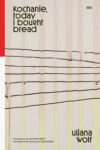I.

Jason Bell’s work has recently appeared in Guernica, Vice, The Brooklyn Quarterly, and Alimentum. He writes a monthly column for Full Stop about food and culture and lives in New Haven, CT, and St. Louis, MO.
For Christmas 1971, Elizabeth Bishop gave Frank Bidart a copy of Fannie Farmer’s Boston Cooking School Cook Book. On the title page, she wrote a short poem:
You won’t become a gourmet* cook
By studying our Fannie’s book—
Her thoughts on Food & Keeping House
Are scarcely those of Levi-Strauss.
Nevertheless, you’ll find, Frank dear,
The basic elements** are here.
And if a problem should arise:
The Soufflé fall before your eyes,
Or strange things happen to the Rice
—You know I love to give advice.
Elizabeth
* forbidden word
** “ “ phrase
P.S. Fannie should not be underrated;
She has become sophisticated.
She’s picked up many gourmet* tricks
Since the edition of ’96.
When Lloyd Schwartz asked Bishop whether he could publish the poem in Elizabeth Bishop and Her Art, she answered, “I suppose it is all right to print the Fanny Farmer dedication — but perhaps it shd. say, in ( )’s, A present to Frank Bidart — or else a longer title, a la Wordsworth — ‘Lines written in a copy of F F’s Boston Cooking School Cook Book, given to Frank Bidart’ . . . ?” I discovered the inscription and the story of its original publication in a handsome blue and gold volume titled Poems, which includes a section of manuscript facsimiles after Bishop’s uncollected translations.
Reading this poem in Bishop’s handwriting, a half-cursive in ballpoint, ink fading out along the bottom edge of a billowing s or the downstroke of her capital C, brings us closer to why Schwartz needed to ask permission than the transcription of the poem on the facing page. The verse is private, intended for a friend’s amusement, but there is also something embarrassing about the fact that anyone besides Frank might take an interest in the poem. The idea that scholars would care about the kind of silly note we might scribble in a yearbook or tuck into a basket of cranberry nut muffins — however cruder than Bishop’s compact wit — explains Bishop’s comically inflated title. By making it seem as though these lines are serious poetry, she deflects attention from their improvisatory but crafted humor, their vulnerability, and their intimacy.
Bishop’s present to Frank Bidart says nothing of significance, at least to the stranger who comes to the page in an anthology. We know Bishop and Bidart through their poetry, not, for the majority of the public, through personal experience. The note can only refer to the friendship of strangers whose intimacy we happen upon by the accident of reading a posthumously “collected works.” If we saw a similar inscription in a book purchased at a garage sale, we might detect comparable warmth and gravity, the same sense of closeness that pervades Bishop’s poem; but the fact that Elizabeth Bishop and Frank Bidart are poetic demigods alters our encounter with the lines. Like reading Langston Hughes’s yearbooks, the signatures scrawled under his classmates’ photos, we turn to how ordinary, how human the artist is — and to the drama of the slight degree by which genius separates the poet from ourselves. We achieve an intimacy with Elizabeth and Frank in the cookbook, an identification entirely different from reading about food in Bishop’s published work — “coffee and the charitable crumb” (“A Miracle for Breakfast”), “the white bowl of farina” (“Faustina, or Rock Roses”), “the round cakes … about to faint — each turns up a glazed white eye” (“Going to the Bakery”), “fish and bread and tea” (“The Moose”) — or reading her poems dedicated to other poets, like “Invitation to Miss Marianne Moore.” The poem to Frank that opens the cookbook, the gift that begins the gift, tells us nothing except what it might be like to be spoken to, in such intimate terms, by Elizabeth.
II.
It is difficult to imagine how a kimono fits the body when it is suspended on a cruciform frame behind glass. At the moment there is an exhibit at the Metropolitan Museum of Art called “Kimono: A Modern History” in which rooms of cases display robes draped in the form of a greeting, a hug, a stretch, death by firing squad in The Third of May 1808, frozen in the shape of furthest extension. Although the kimonos are an opportunity to learn about the history of women and class in Japan from the 16th century to the present, they seem so lifeless that I leave the exhibit congested with ideas that have lost their vital signs. Fittingly, one theme of the exhibit is tagasode — “Whose Sleeves?” — a motif popular in Japanese love poetry:
The fragrance seems even more alluring than the hue,
Whose sleeves have brushed past?
Or would it be this plum tree blossoming here at home?
Painted on a folding screen from the late 16th century, a kimono rests on a rack, its emptiness a reminder of an absent beloved. Her perfume, the movement of silk across her skin, deflated as mementos to her presence. Like a passage of prose that we can paraphrase but not recite, or a fragment of a melody we cannot complete or a limb severed we cannot feel or a life reversed we cannot recover.
What we do not have in “Kimono: A Modern History” is the way a robe clings and folds, how it slips through the air and lies on a calf or wrist, how the sleeves rustle and rip in jealous hands, the knot at the bosom or glimpse of fingertips under a blue curtain. How the images painted or dyed into a kimono come alive on the body and acquire new meaning in motion. A shimmer of cerulean silk embroidered with goldfish, a carp splashing across the bottom hem or a spray of plum blossoms. While it is possible to hang a kimono on a frame and call it art, a perverse visitor will always ask “whose sleeves?” as he would not ask “whose picture?” because the question of who owned an artwork seems irrelevant for the exact reasons the question of who owned a kimono seems crucial. If the kimono on the body is more than art, as the poem spoken or the recipe cooked is more than text, more intimate, more exposed, then how can we come to know the kimono behind glass?
Read the second part of Jason’s Ideas on Intimacy here.
This post may contain affiliate links.







